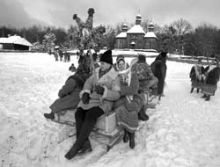The Pyrohiv Museum of Folk Architecture and Lifestyle ranks among Kyiv’s main landmarks. By taking a tour of house displays brought here from every corner of Ukraine, a visitor can learn about the whole country and relive its history in the space of several hours. Not surprisingly, the Pyrohiv Museum is the only Ukrainian museum that is a member of the European Folk Art and Craft Federation.
Meanwhile, the whirlwind of development seems to have reached even this sanctuary. A municipal development meeting at Kyiv’s city hall recently considered a new layout plan and concept to develop the State Museum of Folk Architecture and Lifestyle. This concept by the State Research Institute of the Theory and History of Architecture and Municipal Development details the museum’s boundaries, and targets houses in need of renovation and sites for possible construction of facilities that will become part of the museum’s infrastructure. At the museum’s center, near the ponds, developers plan to cut down tall and damaged trees that obstruct the panoramic view, and to replace them with shrubs. A new exhibit called the Rye Field will open here soon to let visitors get a feel for the Ukrainian countryside. In the early 1990s a decision was approved to expand the museum by resettling 35 families from the nearby village of Pyrohiv and to annex this land to the museum premises. So far only half of the families have been resettled, but should the city fathers find enough money, the remaining villagers will have to be ready to pack soon.
The museum premises border on Holosiyiv Forest and the site of an ancient settlement. These sites, much like the exposition itself, are landmarks of national significance. The initiators of the project emphasize the need to treat history with kid gloves. Yet, in their report they mention the possibility of building low-rise houses that would “hide in the folds of the landscape” without obstructing the overall panoramic view. This has raised concerns among the members of the municipal development board about possible influential customers who would not mind buying a plot of land on which to build their own country estate on the museum premises. The board brought its concerns to Mykola Khodakovsky, the museum director, who said that he regularly receives offers from private firms wishing to build a filling station or an entertainment complex on the museum premises. Even though the museum has not accepted a single offer, a fence has been erected on the museum premises, behind which “some construction project is underway.” Although he hasn’t received offers from individuals wishing to build country estates, Mr. Khodakovsky is certain there are such people, and for that reason he is equally concerned about the future and wellbeing of the museum that has been placed in his care.
However, given current widespread construction at Kyiv’s historic sites, such a probability is more than likely. Even the Sophia preserve in central Kyiv has not escaped the horror of a nearby high-rise construction project that began over the protests of architects. So what hope is there for a suburban museum? According to Kyiv State Commission of Experts chairman Anatoly Karminsky, the old resolution whereby the village territory is to be annexed to the museum premises still stands, but it is not yet clear whether the exposition will be expanded and with what money. Some developers are already eyeing these “folds of landscape.” Meanwhile, experience has shown that it is virtually impossible to force a landowner to observe building height restrictions. There’s no guarantee that the private cottages will not become blights on the natural landscape, which is under state protection.
Mykola Zharykov, who chaired Kyiv’s architecture department in the mid-1980s, recalled attempts to seize these prized lands during his tenure. Once he received a complaint that somebody was building a two-story building on protected territory in Pyrohiv. When he arrived at the scene, it turned out that the construction had been ordered by the then director of Kyiv’s Moscow Market. The possibility to begin legal development of this territory was also considered back then. Proposals were made to build an oblast hospital, but city developers decided against it, given the proximity of the Radon specialized industrial complex to an underground radioactive waste storage facility. This circumstance may have saved Pyrohiv from a flood of would-be dacha and country house owners. According to Valentyn Skvortsov, senior fellow at the Institute of Environmental Geochemistry, specialized industrials complexes similar to Radon are now located in six oblasts of Ukraine. They receive waste from pharmaceutical enterprises and other industries that use sources of radiation, with the exception of nuclear power engineering. The process of sealing radioactive waste in metal containers and burying them ten meters underground began only in the early 1990s. How this waste was disposed earlier is anyone’s guess. The institute constantly monitors the storage facility and occasionally detects traces of radon, which is an extremely hazardous gas. In the future, all radioactive waste will be moved to the Chornobyl exclusion zone. But this is a costly and drawn-out process.
Kyiv’s chief architect Vasyl Prysiazhniuk says it is crucial to develop specific guidelines for the development of protected territories, and to recommend that Kyiv City Hall impose a ban on the allocation of land plots in that area. Recently the mayor of Kyiv assured the Pyrohiv museum director that construction in this protected area has been banned.







